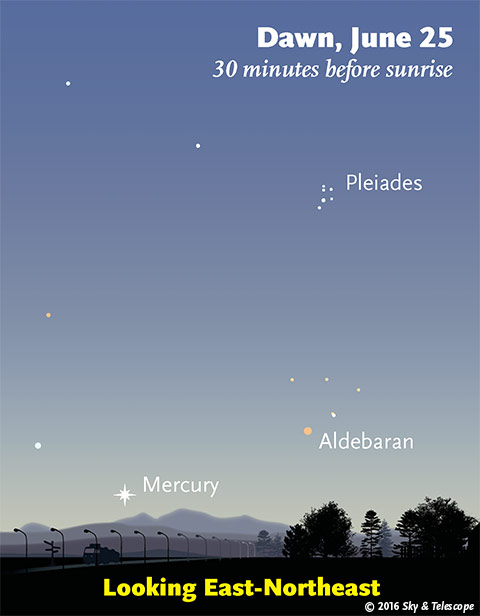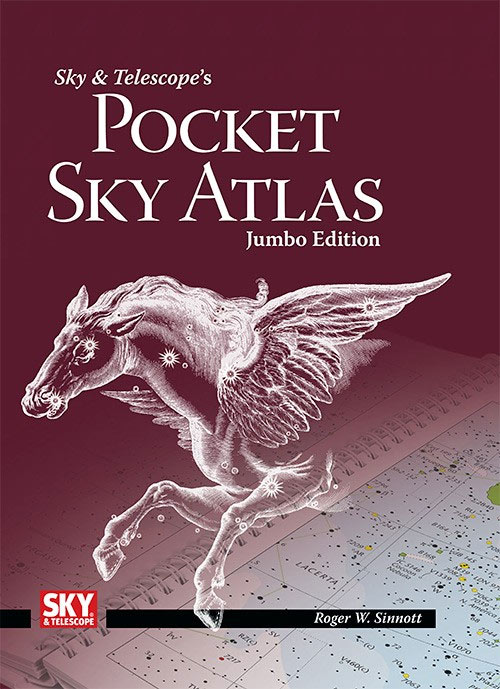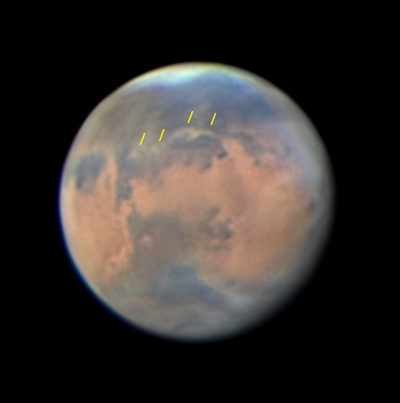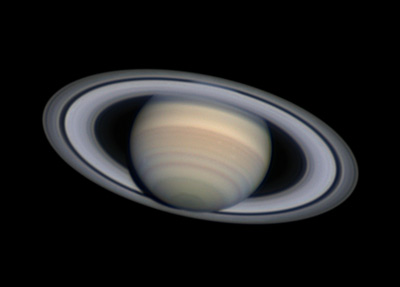This Week’s Sky at a Glance, June 17 – 25

As it waxes toward full, the Moon joints the Mars-Saturn-Antares show. (The Moon's positions in these scenes is always exact for the middle of North America.)
Friday, June 17
• The Moon, Mars, and Saturn make a wide, flattish triangle tonight, as shown here. The longest side connects the two planets, 18° apart.
• A 3-inch telescope will show Saturn's biggest and brightest moon: Titan, magnitude 8.5. Tonight it's west of Saturn, by about four times the length of Saturn's rings. Can you see Titan's orange tint through the moonlight?
Saturday, June 18
• Saturn and the almost-full Moon are 3° to 5° apart this evening (for North America). Saturn is the most distant bright planet, 3,400 times farther away than the Moon right now. Antares, to their lower right, is 3.8 million times farther away than Saturn! Antares shines to us from about 550 light-years away.
Sunday, June 19
• Full Moon tonight and tomorrow night; the Moon is exactly full at 7:02 a.m. tomorrow morning EDT. At nightfall tonight, look for Saturn and Antares well to the Moon's right.
Monday, June 20
• The bright Moon shines in the southeast at the end of twilight. It forms the bottom point of a very long, flat triangle with Saturn about 30° to its upper right and Altair about 30° to its upper left.
• Happy solstice! The Sun reaches its northernmost declination in Earth's sky at 6:34 p.m. EDT, then begins its six-month return southward. This moment is when summer begins in the Northern Hemisphere, winter in the Southern Hemisphere. See Bob King's Solstice Brings Late Nights, Bright Sights.
Tuesday, June 21
• Vega is the brightest star very high in the east. Barely to its lower left after dark is one of the best-known multiple stars in the sky: 4th-magnitude Epsilon (ε) Lyrae, the Double-Double. It forms one corner of a roughly equilateral triangle with Vega and Zeta (ζ) Lyrae. The triangle is less than 2° on a side, hardly the width of your thumb at arm's length.
Binoculars easily resolve Epsilon, and a 4-inch telescope at 100× or more should resolve each of Epsilon's wide components into a tight pair.
Zeta Lyrae is also a double star for binoculars; much tougher, but easily split with any telescope. Delta (δ) Lyrae, below Zeta, is much wider and easier.
Wednesday, June 22
• As evening grows late, even the lowest star of the Summer Triangle climbs fairly high in the east. That would be Altair, a good three or four fists at arm's length below or lower right of bright Vega.
Look left of Altair, by hardly more than one fist, for the compact little constellation Delphinus, the Dolphin.
Thursday, June 23
• Now that there's a long dark spell between the end of twilight and moonrise, tear your telescope away from Mars and Saturn and take a tour of the faint globular clusters swarming nearby, east of Antares. Your guide is Sue French's Deep-Sky Wonders column in the July Sky & Telescope, page 56.

Good luck catching Mercury before sunrise. It's bright but very low. Bring binoculars or a wide-field telescope. It's in Taurus, not a constellation most skywatchers associate with June!
Friday, June 24
• This is the time of year when the two brightest stars of summer, Arcturus and Vega, are about equally high overhead shortly after dark: Arcturus is toward the southwest, Vega is toward the east.
Arcturus and Vega are 37 and 25 light-years away, respectively. They're examples of the two commonest types of naked-eye stars: a yellow-orange K giant and a white A main-sequence star. They're 150 and 50 times brighter than the Sun — which, combined with their nearness, is why they dominate the evening sky.
Saturday, June 25
• At nightfall, look for the Big Dipper hanging straight down in the northwest. Its bottom two stars, the Pointers, point to the right toward modest Polaris, the handle-end of the Little Dipper. Most of the Little Dipper is very dim. This is the time of year when, at the end of twilight, it floats straight upward from Polaris — like a helium balloon escaped from some June evening party.
_________________________
Want to become a better astronomer? Learn your way around the constellations. They're the key to locating everything fainter and deeper to hunt with binoculars or a telescope.
This is an outdoor nature hobby. For an easy-to-use constellation guide covering the whole evening sky, use the big monthly map in the center of each issue of Sky & Telescope, the essential guide to astronomy.

The Pocket Sky Atlas plots 30,796 stars to magnitude 7.6 — which may sound like a lot, but it's less than one per square degree on the sky. Also plotted are many hundreds of telescopic galaxies, star clusters, and nebulae. Shown above is the new Jumbo Edition for easier reading in the night. Click image for larger view.
Once you get a telescope, to put it to good use you'll need a detailed, large-scale sky atlas (set of charts). The basic standard is the Pocket Sky Atlas (in either the original or new Jumbo Edition), which shows stars to magnitude 7.6.
Next up is the larger and deeper Sky Atlas 2000.0, plotting stars to magnitude 8.5, nearly three times as many. The next up, once you know your way around, is the even larger Uranometria 2000.0 (stars to magnitude 9.75). And read how to use sky charts with a telescope.
You'll also want a good deep-sky guidebook, such as Sue French's Deep-Sky Wonders collection (which includes its own charts), Sky Atlas 2000.0 Companion by Strong and Sinnott, or the bigger Night Sky Observer's Guide by Kepple and Sanner.
Can a computerized telescope replace charts? Not for beginners, I don't think, and not on mounts and tripods that are less than top-quality mechanically (meaning heavy and expensive). And as Terence Dickinson and Alan Dyer say in their Backyard Astronomer's Guide, "A full appreciation of the universe cannot come without developing the skills to find things in the sky and understanding how the sky works. This knowledge comes only by spending time under the stars with star maps in hand."
This Week's Planet Roundup

The yellow ticks point down to dust clouds brewing on Mars on the night of June 14–15. South is up. The most distinct clouds are just south of Aurorae Sinus, in the area of the Valles Marineris canyon system (not visible). Glenn Jolly of Gilbert, Arizona, took this image with a 14-inch scope at 5:57 June 15th UT.

Jupiter as imaged by Christopher Go on June 15th. South is up. The Great Red Spot remains vivid. The dark material that has been lining the Red Spot Hollow seems to be breaking up on the following (right) side.

Saturn's rings are wide open this season, tipped 26° to our line of sight and extending above the planet's north and south poles. Damian Peach took this image with a 14-inch Schmidt-Cass on March 19th. South is up.
Mercury (brightening from magnitude –0.4 to –1.0 this week) is having a very low apparition in the dawn. Look for it just above the east-northeast horizon 20 or 30 minutes before sunrise. Late this week, use binoculars to pick up fainter Aldebaran emerging to Mercury's right or upper right.
Venus is hidden behind the glare of the Sun.
Mars (magnitude –1.6, in Libra) remains big and bright; it was closest to Earth on May 30th. It's the yellow-orange thing shining in the south during evening, only a trace less bright than white Jupiter in the west-southwest.
Mars is shrinking, from 17.7 to 17.0 arcseconds in diameter this week, as Earth pulls ahead of it in our faster orbit around the Sun. See our telescopic guide to Mars in the April Sky & Telescope, page 48, or the version online. And set our Mars Profiler for your time and date.
Jupiter (magnitude –2.0, in Leo) stands in the west-southwest during twilight. It moves lower in the west after dark and sets around midnight. In a telescope Jupiter has shrunk to 35 arcseconds wide, almost the smallest it ever appears. See our telescopic guide in the March Sky & Telescope, page 48.
Saturn (magnitude +0.1, in southern Ophiuchus) is the bright object about 20° left of Mars at dusk. To Saturn's lower right by 6° or 7° is slightly fainter Antares. Look near the middle of the Mars-Saturn-Antares triangle for Delta Scorpii (Dschubba). See our telescopic guide to Saturn in the June Sky & Telescope, page 48.
Uranus (magnitude 5.9, in Pisces) is the east just before dawn begins.
Neptune (magnitude 7.9, in Aquarius) is higher in the southeast just before dawn.
__________________________
All descriptions that relate to your horizon — including the words up, down, right, and left — are written for the world's mid-northern latitudes. Descriptions that also depend on longitude (mainly Moon positions) are for North America.
Eastern Daylight Time (EDT) is Universal Time (UT, UTC, or GMT) minus 4 hours.
__________________________
“This adventure is made possible by generations of searchers strictly adhering to a simple set of rules. Test ideas by experiments and observations. Build on those ideas that pass the test. Reject the ones that fail. Follow the evidence wherever it leads, and question everything. Accept these terms, and the cosmos is yours.”
— Neil deGrasse Tyson

No comments:
Post a Comment